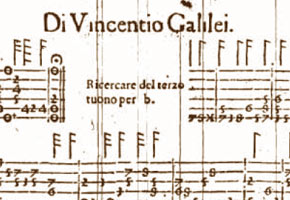

Book tells about the contribution of Galileu Galilei’s father to the history of music and science and his musical divergence with his son
Study tells about the contribution of Galileu Galilei's father to the history of music and science and his musical divergence with his son
Study tells about the contribution of Galileu Galilei's father to the history of music and science and his musical divergence with his son

Book tells about the contribution of Galileu Galilei’s father to the history of music and science and his musical divergence with his son
By Elton Alisson
Agência FAPESP – Aside from being an astronomer, physicist, mathematician and philosopher, Galileu Galilei (1564-1642) was also educated in music, about which he wrote in one of his theoretical treatises. However, the Italian scientist’s conception of music was very different than that of his father, the practicing and theoretical musician Vincenzo Galilei (1533-1591).
In contrast to what Galileu and some musical theoreticians believed in the 16th century, Vincenzo showed that music couldn’t be based on the abstract Pythagorean ideas held to be true in the age of whole-number ratios, but rather on the physical sound phenomenon.
The story of the contribution of Galileu’s father the history of music and of science is told in the research book Vincenzo Galilei contra o número sonoro, (Vincenzo Galilei against the sonorous number) published with FAPESP funding through its Research Support—Publications program.
Result of a doctoral thesis in the History of Science by researcher Carla Bromberg at the Pontifícia Universidade Católica (PUC) in São Paulo as a FAPESP Fellow, the book talks about a period before the Scientific Revolution on which, the author says, few studies in the History of Science exist.
“The sixteenth century is usually annexed onto the 17th in the historiography of science and its characteristics end up being disregarded,” Bromberg told Agência FAPESP. “This period is very important in the history of science because it was then that theoretical treatises on the so-called sub alternate fields like music and optics were written. In them, the authors showed discontent in relation to nature and its sciences and proposed arguments that led to their reclassification.”
In some of these theoretical treatises, Vincenzo Galilei questions the mathematical fundamentals of music. At the time, music wasn’t classified on a sonic basis, measured through units of frequency for example but on a mathematical base understood as a “sonic number”.
“Even though at the time both theoretical and practical music existed, theoretical music followed a Platonic-Pythagorical tradition defended by Galileu and some theoretical musicians. Its foundation was arithmetical,” explained Bromberg.
According to her, through a series of demonstrations, mathematical calculations and philosophical arguments, Vincenzo proved the inefficacy of the mathematical base for music. To do this, the musician, who played the lute, performed many studies on the behavior of materials and the musical instruments of the time. And using the philosophy of Aristotle, (384-322 BC) he managed to establish a new foundation for music which, during that age, was considered to be a science.
“This fact is very interesting because the history of science in the 17th century says that it was only after the Aristotelian method was rejected that people could arrive at a new, more modern concept of science,” said Bromberg.
“In the case of Vincenzo Galileu in the 16th century, it was precisely due to Aristotle’s philosophy that he managed to discover concepts and develop a theory to take music off the mathematical pedestal and bring it into the field of acoustics,” she said.
According to Bromberg, one of the main characteristics of music in the 16th century was polyphony—musical composition for many independent voices all carrying the same level of importance.
In a number of treatises, Vincenzo Galileu began to unify this musical system of multiple independent voices and transform it into a system resembling the one used today, composed of diatonic scales (which have a determined tone in relation to a principal musical note).
Because of this, it can be said that the musician anticipated the publication, in 1722, of “The Well-Tempered Clavier” by Johann Sebastian Bach (1685-1750). In the work, the German composer wrote a set of compositions for the keyboard instrument using the diatonic scale as the “seasoning” to calculate the intervals between musical notes.
“Because of this practice with the diatonic scales, he was able to calculate musical intervals with mathematical reasoning, that weren’t used by theoreticians in his time. He shows that mathematics for music is an instrument, but not its definition and its concepts can’t be based in it,” said Bromberg.
It is not known whether Galileu, who probably also played lute, accepted his father’s musical theory, which was not well received in his day. The work was acknowledged for the first time by the natural philosopher Marin Mersenne (1588-1648) in the seventeenth century and quoted in “The first history of Italian Music from the 18th Century,” by Giovanni Battista Martini (1706-1784).
“Some science historians began trying to relate the musical work of father and son during the 1960s and 70. But Galileu probably didn’t use the new musical concepts that Vincenzo elaborated,” said Bromberg.
Republish
The Agency FAPESP licenses news via Creative Commons (CC-BY-NC-ND) so that they can be republished free of charge and in a simple way by other digital or printed vehicles. Agência FAPESP must be credited as the source of the content being republished and the name of the reporter (if any) must be attributed. Using the HMTL button below allows compliance with these rules, detailed in Digital Republishing Policy FAPESP.





